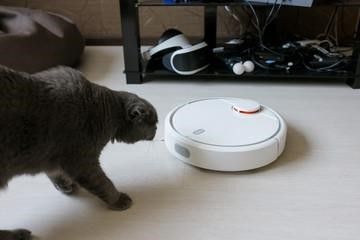Zuigerphobia - Handling Pets that are Scared of Vacuum Cleaners
Zuigerphobia: A Comprehensive Guide to Helping Pets Overcome Fear of Vacuum Cleaners
 Understanding the Root Causes
Understanding the Root Causes
At Think Vacuums, with our extensive experience spanning decades in the vacuum industry, we understand the unique challenges pet owners face when their furry friends develop a fear of vacuum cleaners, known as zuigerphobia.
This guide delves into the causes of this fear and offers detailed strategies to help alleviate it, ensuring a more harmonious home environment.
Understanding Zuigerphobia: Why Pets Are Afraid of Vacuums
Root Causes of Fear in Pets:
- Loud and Startling Noises: Vacuum cleaners produce a noise level that can be distressing for pets. Dogs, in particular, have acute hearing that makes the sound of a vacuum significantly more intense and frightening.
- Unfamiliar and Confusing Odors: The distinct smell produced by a vacuum cleaner, often a mix of dust particles and heated motor components, can be unsettling for pets whose primary sense is smell.
- Strange Appearance and Movement: To pets, the vacuum’s size, shape, and movement may appear alien, which can trigger a natural defensive or fearful response.
- Infrequent Exposure: Unlike other household items, vacuums are used intermittently, which prevents pets from becoming used to them, thus heightening their fear when they do appear.
Strategies to Help Pets Overcome Zuigerphobia
 Management Techniques:
Management Techniques:
- Create Safe Distances: During vacuuming, place your pet in another room or outdoors to alleviate their stress. This simple action can significantly reduce their anxiety.
- Walks During Cleaning: Arrange for someone to take your pet for a walk while you vacuum. This not only helps them avoid the stress but also channels their energy positively.
Desensitization and Training:
- Gradual Introduction: Start by placing the vacuum cleaner in a visible but inactive position, allowing your pet to explore and sniff it without fear.
- Controlled Activation: Turn on the vacuum at a distance, increasing the volume and proximity over time as your pet becomes more comfortable. This should be done gradually to prevent triggering their fear.
- Positive Reinforcement: Reward your pet with treats, affection, and praise when they remain calm in the presence of a vacuum. This helps build positive associations with the vacuum cleaner.
Behavioral Adjustment Strategies:
- Consistency is Key: Regularly using the vacuum can help pets get accustomed to its noise and presence, reducing fear through familiarity.
- Establish Safe Spaces: Provide a designated area, such as a favorite bed or a quiet corner, where your pet can retreat to during vacuuming. This bolsters their sense of security.
Specialized Solutions and Tools
Pet-Friendly Vacuum Options:
At Think Vacuums, we offer a selection of vacuums specifically designed to minimize disturbance in pet-friendly homes:
- Low-Noise Technology: These vacuums operate at reduced noise levels, making them less intimidating for sensitive pets.
- Efficient Pet Hair Attachments: Specialized tools adeptly handle pet hair and dander, reducing cleaning time and stress for both pets and owners.
Professional Support and Guidance:
- Expert Consultation: Our knowledgeable team is ready to provide tailored advice and solutions to address your pet’s specific needs and ensure compatibility with your cleaning routine.
Conclusion
Zuigerphobia, while common, is a manageable issue with the right approach and tools. By implementing these strategies and utilizing pet-friendly vacuum options from Think Vacuums, you can help your pet overcome their fear and enjoy a peaceful, stress-free home.




Log In
Create New Account